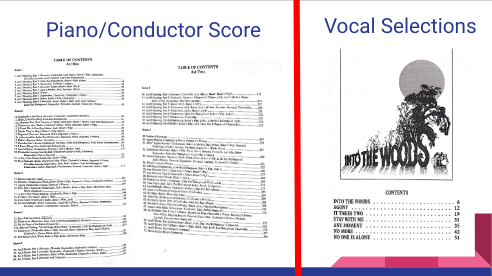Theater Arts 2 terms
5.0(1)
Card Sorting
1/35
Earn XP
Description and Tags
Study Analytics
Name | Mastery | Learn | Test | Matching | Spaced |
|---|
No study sessions yet.
36 Terms
1
New cards
AABA Form
A musical structure format indicating that the song begins with an A section (typically 8-measures) that is followed by a second A section (typically 8-measures with possibly the same melody but different lyrics) and then followed by a B section (typically 8-measured with different melody AND different lyrics), then returning to another A section.
Typical of early and mid-twentieth century musical theatre musical; rarely used in modern musical theatre
Typical of early and mid-twentieth century musical theatre musical; rarely used in modern musical theatre
2
New cards
Air
The term is used to describe any point within a song that the singer is not singing. The introduction, instrumental-only sections, and any music between the end of the vocal and the end of the song itself would be considered air.

3
New cards
Arpeggio
A somewhat rapid succession of notes that are often, but not always, common to a particular musical chord played by the pianist either upward or downward throughout the musical range. Sometimes an arpeggio will appear as the "lead-in" to the vocal entrance.
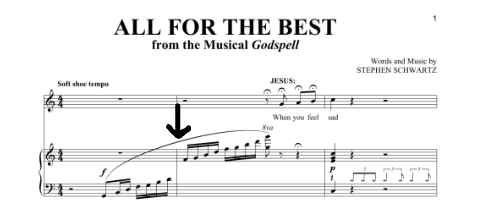
4
New cards
Bar
In musical structure, bars indicate the separation of groups of beats for the sake of organization and for emphasis.
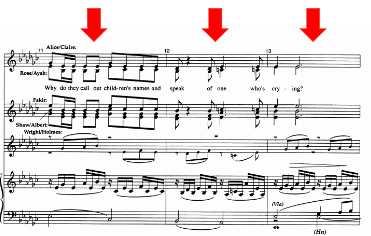
5
New cards
bell tone
Most often, the bell tone is the starting note of the vocal line of the song for the singer's reference ("What's my first note?") The bell tone may be used when there is no introduction to the song or where there is an introduction and the bell tone appears at the end of it.
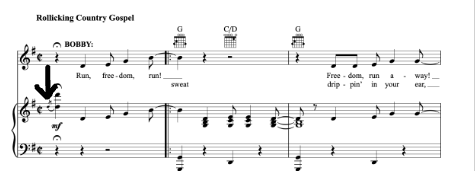
6
New cards
Book(1)
The "book of a musical" may be used as a slang term for the libretto of a show. Book and libretto are actually two different terms - the libretto is the sum of all text (dialogue and lyrics). Sometimes even the dance may be considered part of the libretto when used in a musical to tell the story. The book of a musical is the script or the text in the piece that is not sung (dialogue).
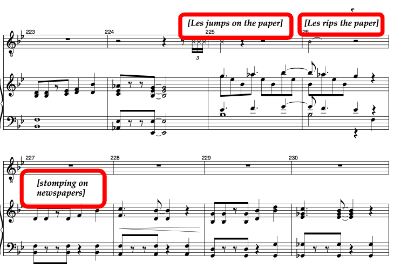
7
New cards
Book(2)
The Singer's Songbook
The book is the collection of songs - most often placed in a notebook or binder - tailored for and used by the singer for auditions and on other performance occasions.
The book is the collection of songs - most often placed in a notebook or binder - tailored for and used by the singer for auditions and on other performance occasions.
8
New cards
Caesura
Railroad tracksAny point within a musical entity in which the music comes to a halt and there is silence. The caesura may be used for pragmatic (stage business) purposes, dramatic effect (the character is having a realization), or for other means if desired. The term "railroad tracks" is slang and is often used in musical theatre language and designated to two parallel lines slanting upward from left to right.

9
New cards
Catch Breath
A quick breath taken by the singer within a relatively brief amount of time. Sometimes known as "top off" breaths, these are taken by the singer needing supplemental air to complete the vocal line if it a particularly long one. Catch breaths should always be approached with discretion so as to not have the effect of adding punctuation to the musical sentence.
10
New cards
Chord symbol
An indication on sheet music of the musical "progression" of the song. The presence of the chord symbol very often appears in theatre and other music above or within the piano accompaniment. This is because of the often improvisatory nature of theatre music as well as musical shorthand.
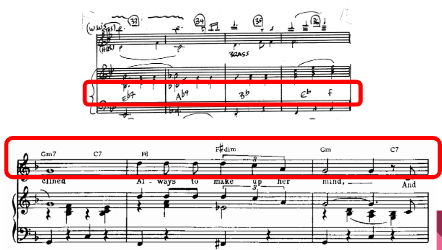
11
New cards
Chorus
For solo musical theatre, the chorus refers to a section of a song also commonly referred to as the 'refrain' and not a collective body of singers. The chorus of a song generally occurs after the verse and it typically contains the same melody (but often different lyrics) each time it appears, whereas the verse may or may not deviate upon repetition from its original musical statement.
12
New cards
Coda
Most often the final section of a song that may include slightly or even very different musical material than that which as preceded it. Generally, but not always, the sheet music will indicate "DS al coda", which means return to the DS (Dal segno) sign, which looks like a sideways S with a line through it and two dots on either side on the sheet music, and then follow the music through to the "to coda" sign - which resembles a cross with a circle or the crosshairs of a rifle scope. At that juncture, skip to the coda to conclude the song.
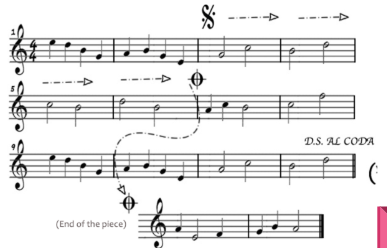
13
New cards
Colla Voce
Written instructions on sheet music for the pianist, conductor, or other instrumentalist to follow the soloist's musical phrasing. If the soloist choose for musical or dramatic effect to slow down or move quickly through a musical phrase or part of a musical phrase, then this could be indicated to the accompanist as Colla voce (Italian term for "with the voice").
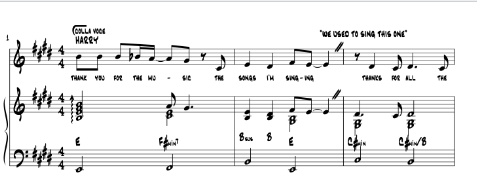
14
New cards
Diphthong
A sound formed by the combination of two vowels in a single syllable, in which the second begins as one vowel sound and moves toward another. Could also be a term used to describe when one sung, sustained vowel sound becomes two vowel sounds.Diphthongs are generally through to interrupt the fluidity of the 'proper' vocal tone, but they are sometimes used to great effect in sung music. Should the singer wish to engage a Southern accent in the singing or if singing in the rock/pop style, the use of diphthongs may be an effective tool.
15
New cards
Downbeat
the first beat of a musical measure
16
New cards
Dynamics
musical instructions on a page that direct the level of volumes of which music should be played/sung and heard.
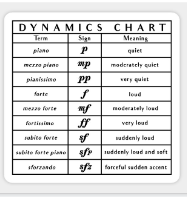
17
New cards
Fermata
a musical notation that indicates it is to be prolonged by an unspecified amount
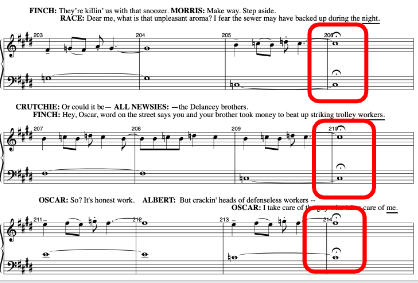
18
New cards
tenuto
A tenuto is similar to a fermata, but the tenuto (often indicated as ten. or a horizontal line over a note) means one of two things: hold the note just beyond its full value or linger on the note, but don't treat is as a fermata.

19
New cards
Staccato
this indicates that the note played shorter than noted usually half of the value, the rest of the metric is silent. Staccato marks may appear on notes of any value, shortening their performed duration without speeding the music itself

20
New cards
Staccatissimo
Indicates a longer silence after note, making the note very short. Usually applied to quarter notes or shorter

21
New cards
Accent
the note is played longer or with a harder attack than surrounding unaccented notes. May appear on notes of any duration

22
New cards
marcato
the notes are played somewhat louder or more forcefully than a note with a regular accent mark

23
New cards
In tempo
A musical directive that means the reverse of rubato. In tempo means that the music should be performed at a steady even speed, whatever that speed may be
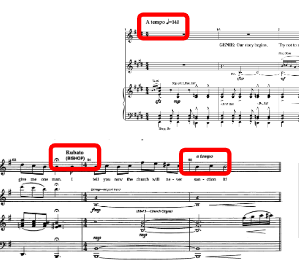
24
New cards
Intro(introduction)
In musical terms, the intro has multiple functions but simply put, it is the music that precedes the first sung note of a song. The into may be short as a single note (a bell tone) or any duration that the composer or arranger deems necessary and/or appropriate. For audition purposes, musical introductions should be kept brief. They need only establish the key and possibly tempo, and the added ‘air’ may not be used by the singer and may be intrusive.
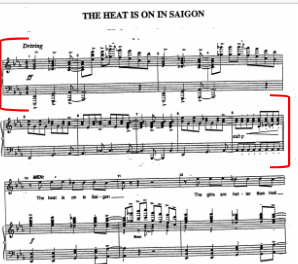
25
New cards
Key Change
A ‘key change’ is a ‘change of key’ that may happen from one section of the musical number to the next for heightened musical effect. An additional meaning: To adjust the key for the singer in order to tailor to the singer’s practical vocal range and/or vocal strengths. Unlike in opera, the music theatre practice of changing keys is commonplace. In the past, changing a key meant writing by hand the transposition note for note, but the advent of musical notation software has streamlined the process considerably.
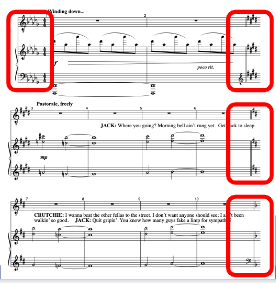
26
New cards
key signature
Appears at the beginning of the piece of music and typically at the beginning of each new line of musical staff. The key signature determines the home base key that the song will be performed in.
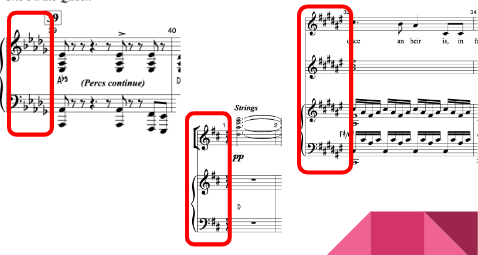
27
New cards
time signature
The time signature indicates how many beats will be designated in each bar of music (top number) and also indicates what kind of note establishes one full beat (bottom number).

28
New cards
Poco and molto
Poco is an often seen musical notation that means “a little” or “not much”. Example: poco rit. means “slow down the music, but only a little”. Poco is often seen as poco a poco as in poco a poco ritardando, which means “slow down the music gradually (little by little).
Molto indicates “by a lot”. For example, molto rit. means “slow down the music quite a bit”.
Molto indicates “by a lot”. For example, molto rit. means “slow down the music quite a bit”.
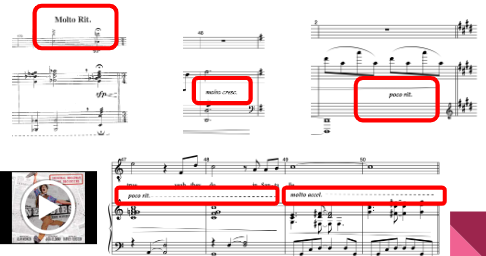
29
New cards
Rideout
The final musical phrase (frequently the final two to four bars) of the song over which the singer is singing (very often a held note). If the singer is not singing over the final phrase, the rideout may be known as an “air rideout”.
30
New cards
Rit. (ritard) and rall (rallentando)
Both mean “slow the music down”, although rall, rather than rit, is often understood to mean “slow the tempo more gradually.” Practically speaking, in the theatre, the two terms are often used interchangeably.
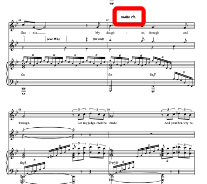
31
New cards
Stinger
A heavily accented musical chord (or a single pitch often played in octaves) that is generally played by the pianist or orchestra at the end of the song, signaling that the number is over (and as a cue for the audience to applaud).
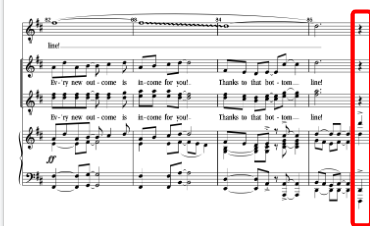
32
New cards
tempo
the rate of speed that which the song is played and sung
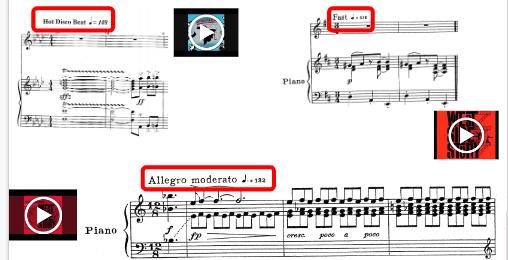
33
New cards
Underscoring
Non-sung music that appears in the musical score to highlight, accompany, or underline stage dialogue or stage business.
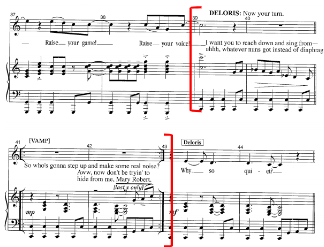
34
New cards
The vamp is a musical device that repeats a certain bar or bars of music over again until it is time for the singer to sing. The usefulness of this convention is very practical: A vamp may be inserted to “buy time” until the dialogue preceding the first sung note has concluded and/or the stage business has been wrapped up or for technical matters (scene change) to be completed.
There are two varieties: “vamp until ready” means that the conductor cues the music to go out of the camp and the next bar of music is the vocal entrance; and the “voice last time”, which means that the vamp music is the same as the first bar or bars of sung music and the singer’s vocal entrance occurs over the last time through the vamp.
There are two varieties: “vamp until ready” means that the conductor cues the music to go out of the camp and the next bar of music is the vocal entrance; and the “voice last time”, which means that the vamp music is the same as the first bar or bars of sung music and the singer’s vocal entrance occurs over the last time through the vamp.
Vamp
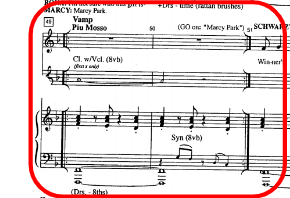
35
New cards
Verse
In “old-fashioned” songs (such as those of Irving Berlin and George & Ira Gershwin), the verse if the portion of the song that precedes the chorus. The verse was expositional information to set up the chorus of the song and this format was virtually invariable. Through the years, as song structure has evolved, the verse has come to mean the portion of the song that preceded the chorus each time the chorus appears, particularly in pop music, and the verse may return with different lyrics and possibly different notes no matter the songwriter’s wishes.
36
New cards
Vocal selection
The folio of music sold in your local sheet music store or online that contains the principal songs (occasionally all) from a musical. Vocal selections vary from full scores (which may also be available store-bought or online) in a number of important ways
